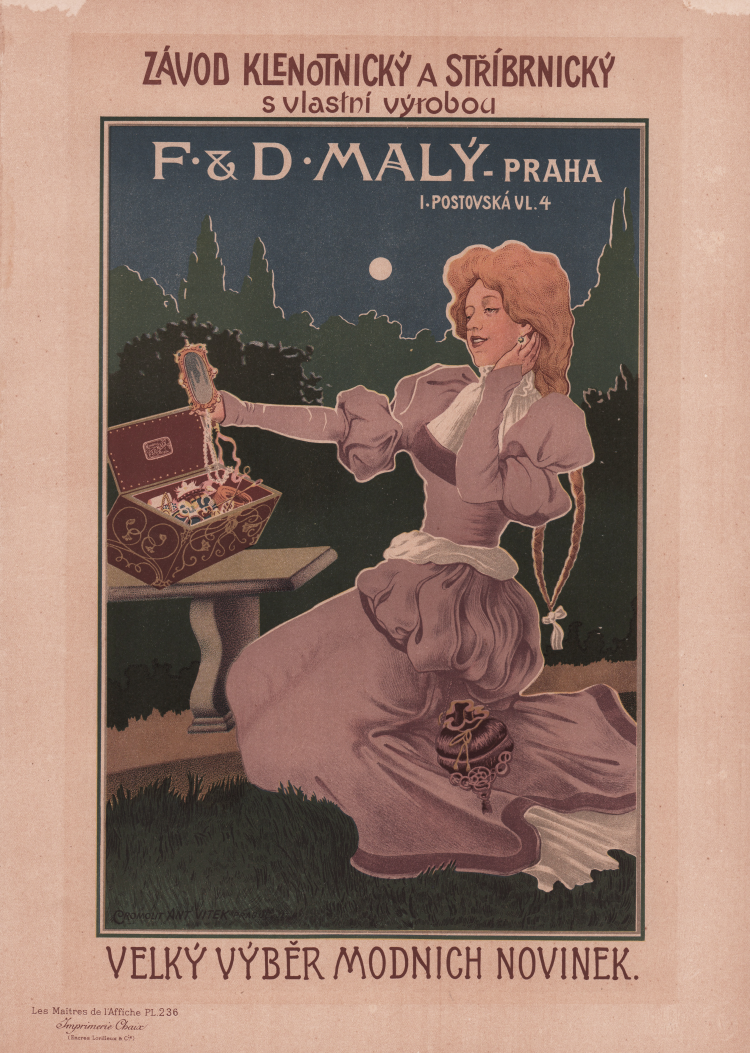



| Reference: | S1671 |
| Author | Karel Reisner |
| Year: | 1900 |
| Measures: | 290 x 400 mm |


| Reference: | S1671 |
| Author | Karel Reisner |
| Year: | 1900 |
| Measures: | 290 x 400 mm |
Lithograph printed in color on tissue paper, in very good condition. Table n° 236 of the fifth annual volume (1900) of Les Maîtres de l'affiche.
By Karel Reisner, composition created for a jewelry store in Prague.
Proof with the embossed stamp of Les Maîtres de l'affiche in the lower right corner (Lugt: L.1777c), signed in the plate, printed at Chaix (Ateliers Chéret) rue Bergère in Paris.
Les Maîtres de l'affiche is a monthly French publication printed in France between December 1895 and November 1900. The idea to create the magazine is of Jules Chéret, at the time artistic director of Chaix, a printing house located in Paris at 20 rue Bergère. Each issue includes four posters reproduced using the technique of chromolithography. Each copy had an embossed stamp of authentication. The sale price was 2.50 francs per issue, while a subscription cost 27 francs. There was also a luxury edition on Japan printed in 100 copies and sold for 80 francs for 12 issues.
In January 1897, a first volume was put on sale that included all the affiches published the previous year; the publication had a preface signed by Roger Marx and had a format created by Jean Engel based on a project by Paul Berthon. Until January 1901, the date of the magazine's closure, a total of five volumes were produced, with 97 artists involved.
The 256 color plates that make up the suite represent a wide-ranging selection of outstanding original posters from the turn of the twentieth century when this popular art form first reached its peak.
Early printed posters were very text-heavy, with relatively few illustrations. After all, they were created to advertise products, and adding an illustration to an advertisement in the mid-1800s was not commonplace. However, during the second half of the nineteenth century, when all types of commercial products were aesthetically upgraded, serious artists began to see the new possibilities in the poster medium. By linking their imagery to modern commerce, the thinking was that each would be enhanced by the value of the other. This was especially true for Jules Cheret (1836-1932) whose unique combination of artistic, technical, and entrepreneurial talents paved the way for an actual poster industry. Cheret opened his own print shop in Paris in 1866 – Imprimerie Chaix – and his work then began to inspire numerous emulators throughout Europe and America.
By the 1890s the streets of every great city were enlivened by large, colorful posters. The posters had not only caught the fancy of the public, but its best examples were already being regarded as true works of art (specifically, as fine prints) to be exhibited, reviewed in journals, and collected and reproduced in a more manageable form. In the last five years of the century, the ebullient spirit of the “Belle Epoque,” gave birth to a new artistic movement. It was during those years that Imprimerie Chaix was to play a significant part in codifying, hallowing, and perpetuating Cheret’s vision through printmaking.
Karel Reisner (Praga 1868 - 1913)
|
Karel Reisner, born on January 28, 1868 in Prague (Bohemia, Austria-Hungary) and died in the same city on March 29, 1913, was a Czech painter, art teacher and poster artist. From 1884 to 1886, Karel Reisner was a student at the Academy of Fine Arts in Prague under the direction of the painter Antonín Lhota (1812-1905), and later under Maxmilián Pirner. From 1886 to 1888, he spent several periods at the Academy of Fine Arts in Munich, where he studied under the painter and art historian Johann Caspar Herterich (1843-1905). From 1901 he taught at the School of Applied Arts in Prague and in 1905 he opened his own school (Soukromá výtvarná škola Karla Reisnera ). Among his many students were Emanuel Hercík, who became famous as an illustrator and designer of wooden toys, and Jan Zrzavý (1890-1977). A contemporary of the painters Árpád Basch, Vojtěch Hynais, Vladimír Županský, and Viktor Olíva, Karel Reisner produced a number of notable objects, illustrations, and posters between 1895 and 1900, including the commission for the jewelry house F. & D. Malý Praha, reproduced in the magazine Les Maîtres de l'affiche (1895-1900) by Jules Chéret.
|
Karel Reisner (Praga 1868 - 1913)
|
Karel Reisner, born on January 28, 1868 in Prague (Bohemia, Austria-Hungary) and died in the same city on March 29, 1913, was a Czech painter, art teacher and poster artist. From 1884 to 1886, Karel Reisner was a student at the Academy of Fine Arts in Prague under the direction of the painter Antonín Lhota (1812-1905), and later under Maxmilián Pirner. From 1886 to 1888, he spent several periods at the Academy of Fine Arts in Munich, where he studied under the painter and art historian Johann Caspar Herterich (1843-1905). From 1901 he taught at the School of Applied Arts in Prague and in 1905 he opened his own school (Soukromá výtvarná škola Karla Reisnera ). Among his many students were Emanuel Hercík, who became famous as an illustrator and designer of wooden toys, and Jan Zrzavý (1890-1977). A contemporary of the painters Árpád Basch, Vojtěch Hynais, Vladimír Županský, and Viktor Olíva, Karel Reisner produced a number of notable objects, illustrations, and posters between 1895 and 1900, including the commission for the jewelry house F. & D. Malý Praha, reproduced in the magazine Les Maîtres de l'affiche (1895-1900) by Jules Chéret.
|